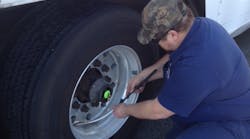Commercial truck tires are the number one maintenance cost for fleets, so they are taken very seriously. With the average price of a radial steer or drive tire in the $500 range and trailer tires about $425, a fleet can spend nearly $10,000 for 18 tires.
Even if the same fleet is retreading its drive and trailer tires, the cost still will be in the $6,000 to $7,000 range per vehicle.
A successful tire program will keep the tire cost per mile in check. A poorly thought through tire program can become a financial disaster.
Tires are designed to carry the vehicle load at a specific tire inflation pressure. Air is what really carries the load. Molded onto the sidewall of every commercial truck tire is the maximum load the tire can carry at a specific inflation pressure.
Typical Mistake
A common error is to inflate the tire to the maximum tire pressure. The correct procedure is to inflate the tire to the recommended tire pressure based on the worst case load scenario that the vehicle or tire will experience.
Every tire manufacturer includes on their website the official load/inflation tables for every tire size and load range. These tables are also broken down into a “single” and “dual” tire category. Regardless of tire make/model, the load/inflation tables are identical.
If your fleet is running light loads, 85 psi might be the recommended pressure for a 295/75R22.5 LR G tire. Meanwhile another fleet may find that 110 psi is the correct pressure, since they are hauling heavy steel products.
Even though tire experts have been preaching how important it is to maintain proper tire pressure for more than 30 years, tire underinflation is still a major issue facing fleets. Why is it still an issue? There are many reasons:
- It takes way too long to manually check 18 or more tires with a gauge.
- You have to bend down and reach inside the wheel well to check the inside duals. That’s not good for the back, and you get dirty.
- Losing valve caps is an issue.
- Tire pressure gauges are notorious for being inaccurate. Brand new, out of the box tire pressure gauges – regardless of vendor – are accurate to only +/- 3 psi. This means that a 100 psi tire can read 97 psi with one gauge and 103 psi using another.
Reason for Air Loss
There are really only four reasons why any tire will lose air:
1. Osmosis. Depending on tire make/model, tires will lose 1 to 3 psi per month through osmosis. Tires are similar to a balloon. You inflate a balloon and, by the next day, the air has dissipated through the membrane via osmosis.
2. Tread area punctures. Tread area punctures is the number one reason why tires lose air. Tires can be checked manually before leaving the yard in the morning and can pick up a nail just moments later.
The common #20 penny nail can lead to a loss of air of several psi per day and, in a few days, you will have a significantly underinflated tire.
3. Sidewall impact breaks. Hitting the curb with the right outside trailer tires while making a turn can lead to a sidewall impact break and a sidewall rupture.
4. Leaking valve stems and cores. Over-tightening valve cores can result in air loss. There is a torque specification of 4 in/lbs for a valve core. There are several suppliers that sell a valve core torque wrench pre-torqued to 4 in/lbs.
A Bad Thing
Why is tire underinflation a bad thing? Tires are designed to run at a specific inflation pressure based on the worst case load. When tires run underinflated, the sidewalls flex significantly leading to excessive heat buildup. Heat is the worst enemy of any tire. High heat leads to reduced retreadability, reduced mileage and kills fuel economy.
Irregular tire wear increases because the tire footprint becomes significantly longer and distorted. The longer and hotter footprint tends to pick up more puncturing objects.
There is no good news when tires run underinflated.
A truly bad scenario is when the inside dual is running at 70 psi and the outside dual at 100 psi. The tire revolutions per mile are quite different between the two tires. The result is one tire scrubbing and bouncing to keep up with the other tire, and irregular wear develops.
When a tire is not running smoothly and evenly the fuel economy drops dramatically.
Trailer Tires
Trailer tires are the poorest maintained tire wheel position for many reasons. Drivers check the steer tires regularly and maybe a few drive tires but trailer tires are typically neglected.
The common solution used by the majority of fleets is the use of automatic tire inflation systems (ATIS) for their trailers. These systems simply add air to the tires whenever the pressure drops below what is set in the system’s control box.
ATIS technology has been around for more than 20 years and is a proven, low maintenance, short ROI solution to keep trailer tires at the optimum pressure all the time. In addition to maximizing tire removal miles, fuel economy and retreadability, these systems dramatically reduce tire related roadside service calls.
Another feature of these systems is that they can be specified on new trailers and can also be retrofitted on existing equipment.
Working with your tire professional is always a good idea when optimizing your fleet’s tire program.
Al Cohn is the director of new market development and engineering support at P.S.I. (www.psitireinflation.com). The company provides automatic tire inflation systems along with customer valued services and tire maintenance-related solutions.




